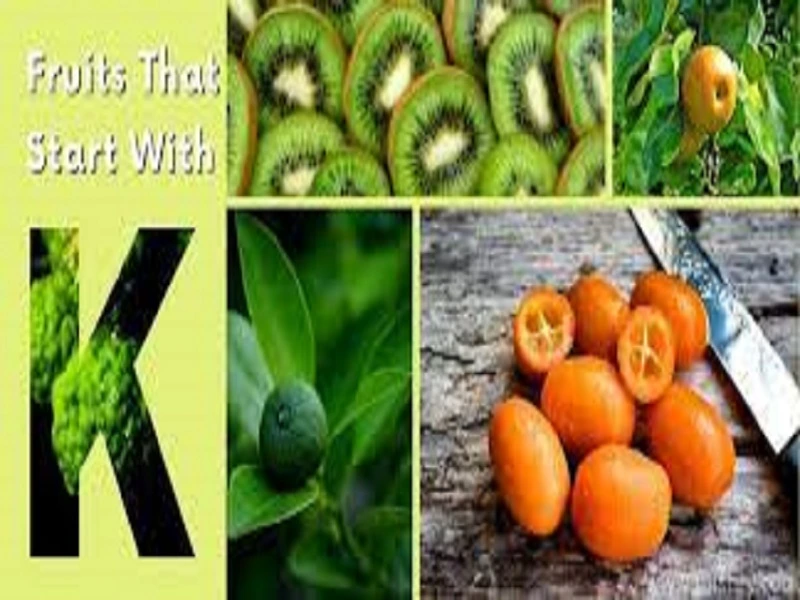
When it comes to exploring the world of fruits, we often encounter an astonishing variety that ranges from the common to the exotic. In this beginner’s guide, we will delve into the realm of fruits that begin with the letter “K.” From well-known favorites to lesser-known gems, these fruits bring unique flavors and nutritional benefits to the table. So, let’s embark on this fruity journey and discover the delightful fruits starting with K!
Introduction
Fruits starting with the letter K might not be as famous as their counterparts from other letters, but they certainly deserve attention for their distinctive taste and health benefits. These fruits come from various parts of the world, and some are seasonal delicacies, while others can be enjoyed year-round.
Kiwifruit
Kiwifruit, also known as kiwi, is a small, green fruit with a fuzzy brown exterior. It has a refreshing, sweet and tangy flavor that instantly pleases the taste buds. Kiwifruit is rich in vitamin C, vitamin K, and dietary fiber, making it an excellent choice for boosting the immune system and aiding digestion.
Kumquat
Kumquat is a tiny citrus fruit that resembles a miniature orange. What sets it apart is that the entire fruit, including the peel, is edible. The taste is a delightful blend of sweet and tart, making it a unique snacking option. Kumquats are abundant in vitamin C, antioxidants, and essential oils, contributing to overall health and well-being.
Kiwano
Kiwano, also known as horned melon or African horned cucumber, is a fascinating fruit with a spiky orange exterior. Its lime green, jelly-like interior houses numerous seeds surrounded by a slightly sweet, cucumber-like flavor. Kiwano is an excellent source of vitamins A, C, and potassium, promoting hydration and healthy skin.
Kaffir Lime
The Kaffir lime, native to Southeast Asia, is a small, bumpy-skinned fruit used primarily for its aromatic leaves in cooking. While the fruit itself is not typically consumed due to its intense bitterness, the leaves add a distinct citrusy flavor to various dishes like Thai curries and soups.
Kakadu Plum
The Kakadu plum, also known as Billygoat plum or Gubinge, hails from northern Australia. This small green fruit has the highest vitamin C content of any fruit in the world, making it a nutritional powerhouse. Traditionally used by Indigenous Australians for its medicinal properties, Kakadu plum is now gaining popularity for its health benefits worldwide.
Kaki Persimmon
Kaki persimmon, often simply called persimmon, is a lovely orange fruit with a smooth, glossy texture. Depending on the variety, persimmons can be sweet and succulent when fully ripe or slightly astringent when not yet fully matured. These fruits are rich in vitamin A, vitamin C, and dietary fiber, supporting healthy vision and gut health.
Kandis
Kandis, also known as Ceylon gooseberry, is a small, round fruit with a tart flavor. It is commonly used to make jams, chutneys, and sauces, adding a tangy twist to various recipes. Kandis is an excellent source of antioxidants, helping to combat free radicals and reduce oxidative stress in the body.
Kiwi Berry
Kiwi berry, also known as hardy kiwi or baby kiwi, is a grape-sized version of the regular kiwifruit. Unlike its larger counterpart, kiwi berries have a smooth, edible skin, and their flavor is often described as a mix of kiwi and berries. These little delights are packed with vitamins and minerals, contributing to a healthy immune system and vibrant skin.
King Coconut
King coconut, a variety of coconut native to Sri Lanka, is renowned for its refreshing coconut water. It has a distinct bright orange shell and contains sweeter water than the regular coconut. King coconut water is a natural hydrator packed with electrolytes, making it an excellent choice for staying refreshed on a hot day.
Knobbed Russet
Knobbed Russet, also known as Knobby Russet or Knuist, is an antique apple variety originating from the Netherlands. The fruit is small to medium-sized with a distinctive rough, russeted skin and a rich, nutty flavor. Although less common than modern apple varieties, Knobbed Russet is favored by apple enthusiasts for its unique taste and appearance.
Conclusion
In conclusion, exploring fruits that start with K introduces us to a delightful array of flavors, textures, and health benefits. From the fuzzy kiwifruit to the exotic Kakadu plum and the tangy kandis, each fruit has its own charm and nutritional value. Incorporating these fruits into our diet can not only enhance our culinary experiences but also contribute to a balanced and nutritious lifestyle.
FAQs
Q1: Are Kiwi berries the same as regular kiwifruit? A1: No, kiwi berries, also known as hardy kiwi or baby kiwi, are smaller and have a smooth, edible skin, unlike the regular kiwifruit.
Q2: Can you eat the peel of a kumquat? A2: Yes, the entire fruit, including the peel, is edible, making kumquats a unique snacking option.
Q3: How can I use Kaffir lime leaves in cooking? A3: Kaffir lime leaves are used to add a distinct citrusy flavor to various dishes, especially Thai curries, soups, and sauces.
Q4: Where can I find Kakadu plum outside of Australia? A4: While Kakadu plum is native to northern Australia, its popularity has led to some international markets offering products containing Kakadu plum extract.
Q5: How can I differentiate between sweet and astringent persimmons? A5: Sweet persimmons are fully ripe and will have a soft, succulent texture, while astringent ones will be slightly firm and may cause dryness in the mouth if not fully matured.
Q6: What are the health benefits of eating Kiwano? A6: Kiwano, also known as horned melon, is a great source of vitamins A, C, and potassium, contributing to hydration and promoting healthy skin.
Q7: Is Kandis related to gooseberries? A7: Despite the name “Ceylon gooseberry,” Kandis is not botanically related to true gooseberries.
Q8: How does King coconut water differ from regular coconut water? A8: King coconut water is sweeter and less nutty in flavor compared to regular coconut water. It is also distinguished by its bright orange shell.

